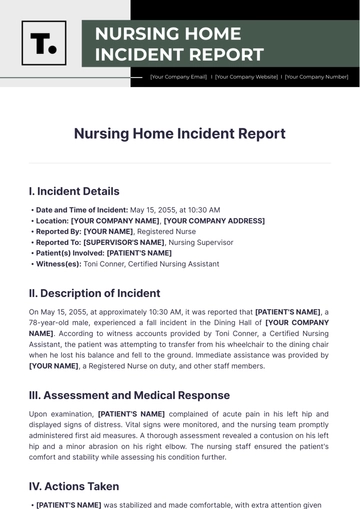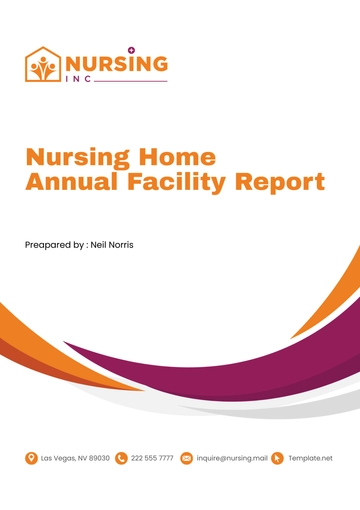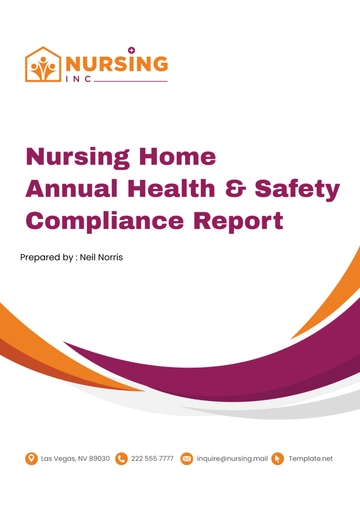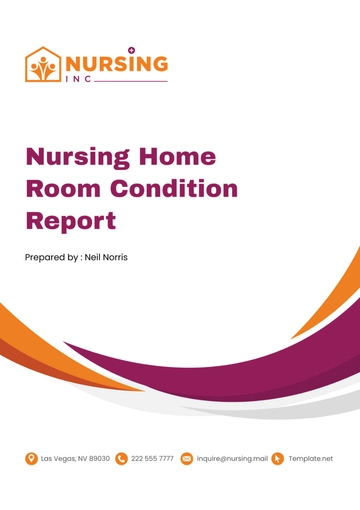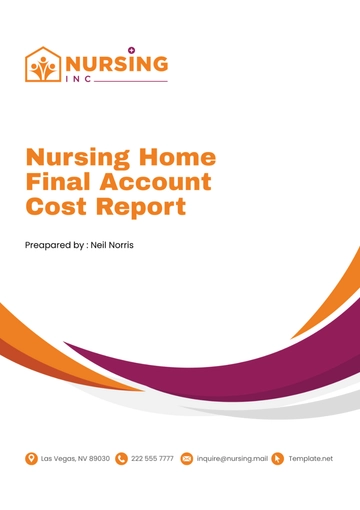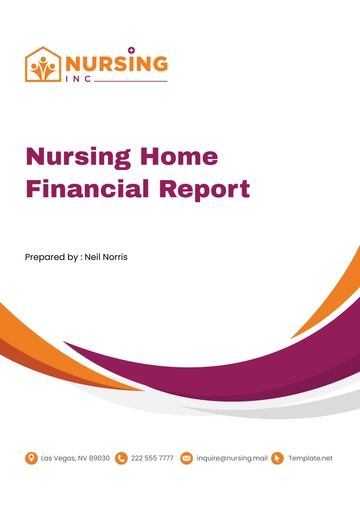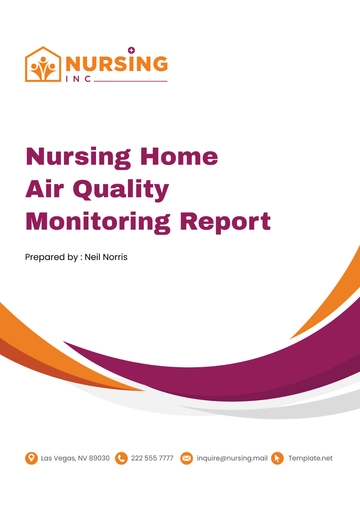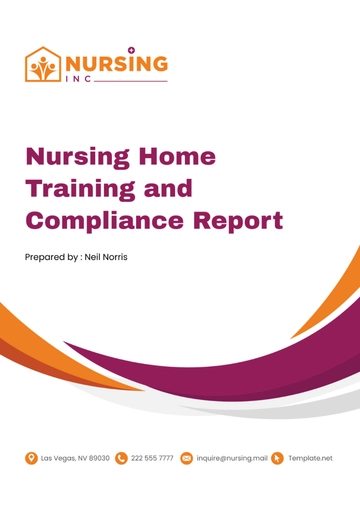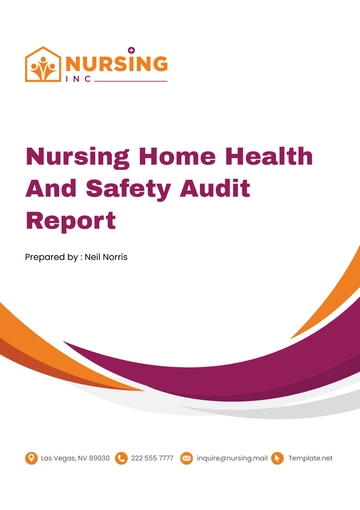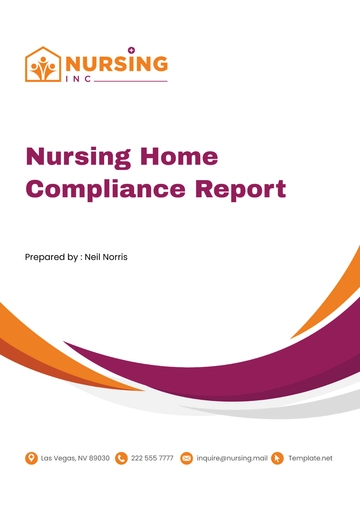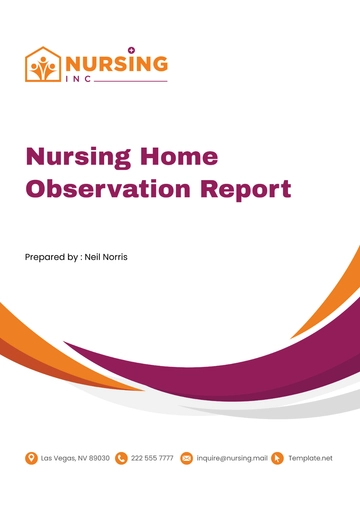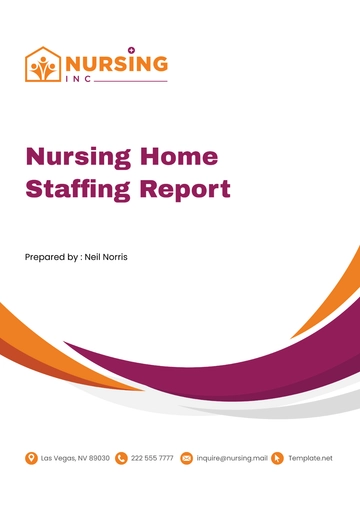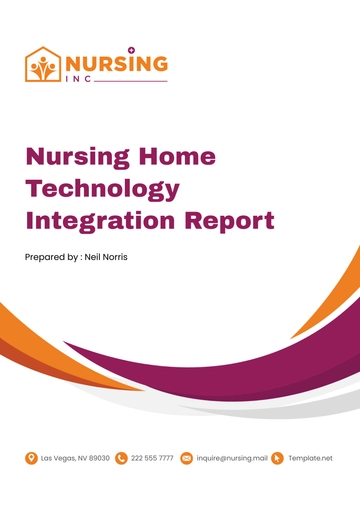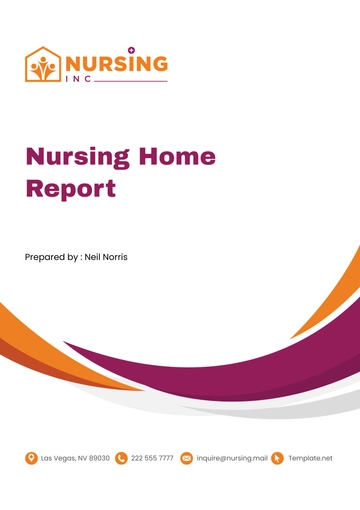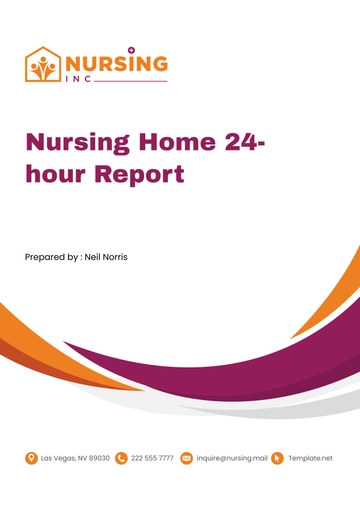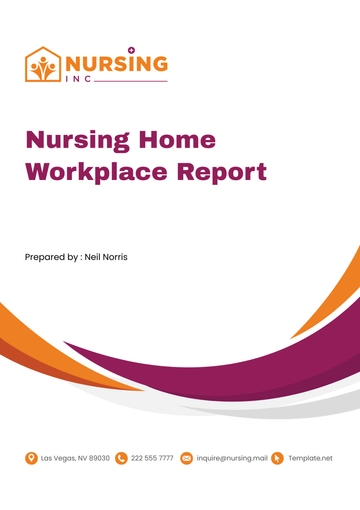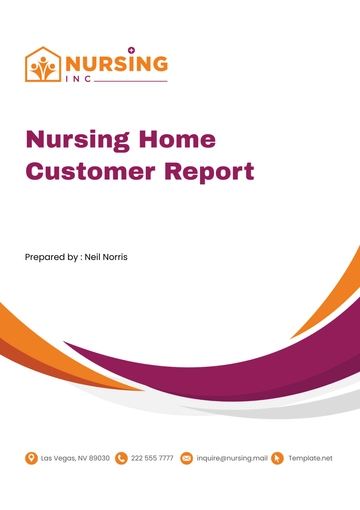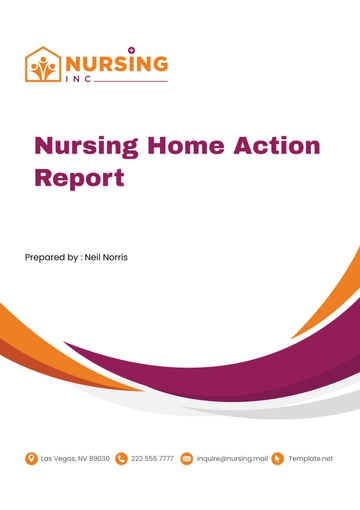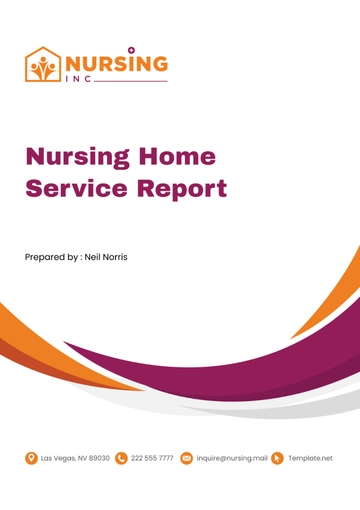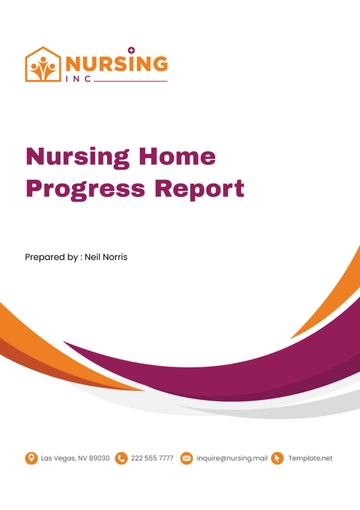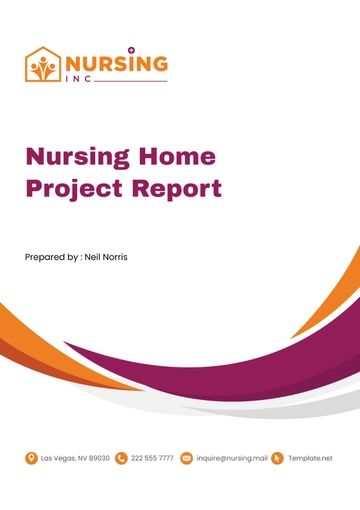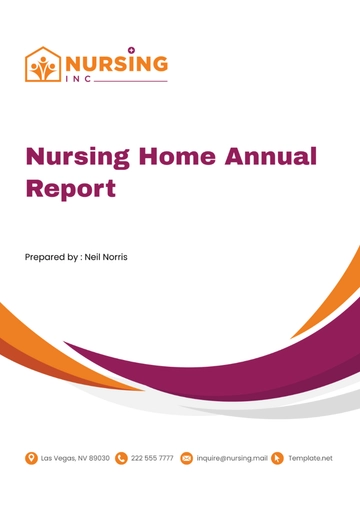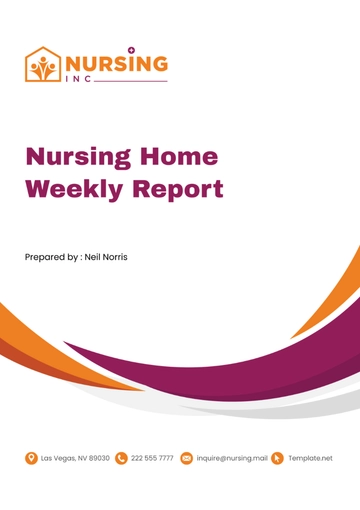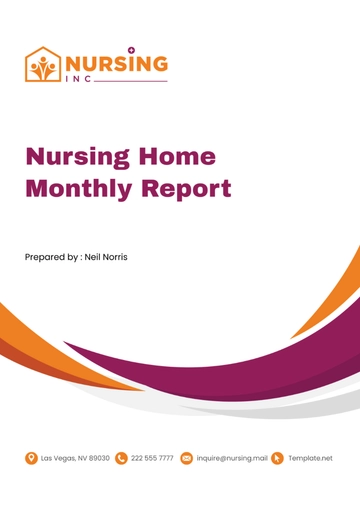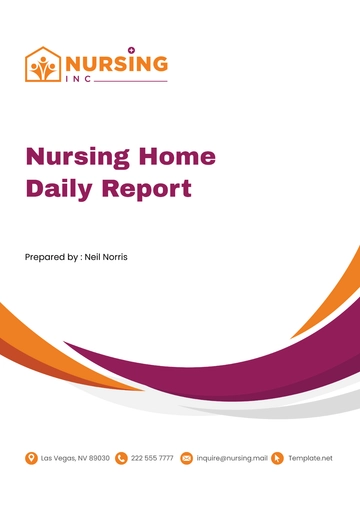Free Nursing Home Report
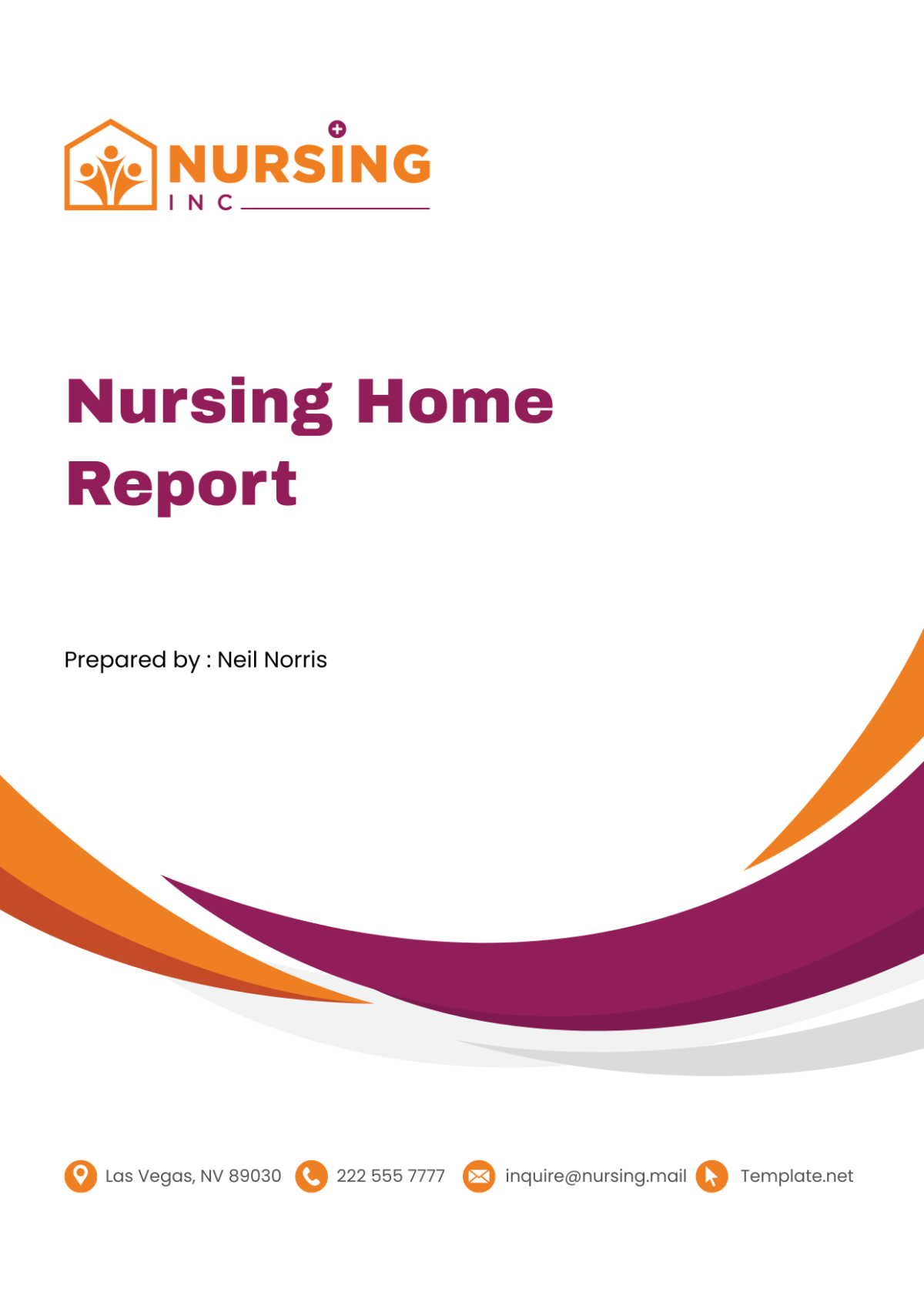
I. Introduction
A. Overview of [Your Company Name] Nursing Home
[Your Company Name] Nursing Home, situated in [City, State], has been a cornerstone of elderly care since its establishment in [Year of Establishment]. Nestled in a tranquil setting, our facility is dedicated to providing compassionate and personalized care to our residents. With a multidisciplinary team of healthcare professionals and modern amenities, [Your Company Name] Nursing Home is committed to ensuring the comfort, safety, and well-being of all residents entrusted to our care.
B. Purpose of the Report
This comprehensive report is designed to evaluate the performance and quality of services provided by [Your Company Name] Nursing Home. By examining key areas such as staffing levels, resident care, compliance with regulations, and overall satisfaction, the report aims to offer valuable insights into the operations of our facility. Furthermore, it seeks to provide actionable recommendations to drive continuous improvement and uphold the highest standards of care for our residents.
II. Executive Summary
A. Key Findings
Staffing Levels: [Your Company Name] Nursing Home maintains optimal staffing levels across all essential roles, ensuring that residents receive attentive and personalized care.
Resident Satisfaction: Feedback from resident satisfaction surveys indicates a high level of satisfaction with the quality of care and services provided by our facility.
Compliance with Regulations: [Your Company Name] Nursing Home demonstrates a strong commitment to regulatory compliance, with adherence to both state and federal regulations evident throughout our operations.
B. Recommendations
Based on the findings outlined in this report, the following recommendations are proposed:
Enhance staff training initiatives to further develop skills and expertise in caring for elderly residents.
Expand recreational and social activities to promote increased resident engagement and overall well-being.
Implement regular audits and quality assurance measures to ensure ongoing compliance with regulatory standards.
III. Methodology
A. Data Collection
To gather comprehensive data for this report, a combination of quantitative and qualitative methods was employed. The following methodologies were utilized:
Staff Interviews: Structured interviews were conducted with key staff members, including nursing supervisors, caregivers, and administrative personnel, to gather insights into staffing levels, training programs, and operational procedures.
Resident Surveys: Anonymous surveys were distributed to residents to assess their satisfaction levels regarding various aspects of care, including staff responsiveness, amenities, and overall quality of life.
Document Review: Relevant documentation, including staffing schedules, incident reports, and regulatory records, was thoroughly reviewed to obtain objective data on compliance and operational performance.
B. Analysis
The collected data underwent a rigorous analysis process to derive meaningful insights and conclusions. Quantitative data, such as staffing ratios and survey responses, were analyzed using statistical methods to identify trends and patterns. Qualitative data from interviews and surveys were analyzed thematically to uncover recurring themes and perceptions. The findings were then synthesized to generate a comprehensive overview of [Your Company Name] Nursing Home's performance across various domains.
IV. Staffing Analysis
A. Staffing Levels
Registered Nurses (RNs)
Staff Category | Number Employed | Avg. Hours per Resident per Day |
|---|---|---|
Registered Nurses | 10 | 0.7 |
Licensed Practical Nurses (LPNs)
Staff Category | Number Employed | Avg. Hours per Resident per Day |
|---|---|---|
Licensed Practical Nurses | 15 | 0.6 |
Certified Nursing Assistants (CNAs)
Staff Category | Number Employed | Avg. Hours per Resident per Day |
|---|---|---|
Certified Nursing Assistants | 30 | 2.0 |
B. Staff Turnover
Staff Category | Turnover Rate (%) |
|---|---|
Registered Nurses | 10 |
Licensed Practical Nurses | 8 |
Certified Nursing Assistants | 12 |
Staff turnover rates were calculated based on the number of departures and new hires within a specified time period. The turnover rate for each staff category was analyzed to assess its impact on resident care and organizational stability. Strategies for mitigating turnover and retaining skilled personnel were explored to ensure continuity of care and staff morale.
V. Resident Care Analysis
A. Quality of Care
Health Outcomes
In evaluating health outcomes, [Your Company Name] Nursing Home assessed several key indicators, including the rate of hospitalizations, the prevalence of pressure ulcers, and the management of chronic conditions. Analysis revealed that our facility maintains favorable health outcomes, with a hospitalization rate below the national average and effective management of chronic conditions such as diabetes and hypertension. Additionally, our proactive approach to preventive care, including regular health screenings and wellness programs, contributes to overall resident well-being.
Medication Management
Our medication management practices were thoroughly reviewed to ensure adherence to prescribed regimens, minimize medication errors, and educate residents on proper medication usage. Through the implementation of electronic medication administration records (eMAR) and regular medication reconciliation processes, [Your Company Name] Nursing Home has achieved a low incidence of medication errors and high levels of resident compliance. Furthermore, our interdisciplinary approach involving pharmacists, physicians, and nursing staff ensures that medication regimens are tailored to each resident's specific needs, minimizing adverse drug reactions and promoting optimal health outcomes.
Fall Prevention
Fall prevention is a critical aspect of resident care at [Your Company Name] Nursing Home, and comprehensive measures are in place to mitigate fall risks and ensure resident safety. Our staff undergo rigorous training in fall prevention strategies, including proper body mechanics, environmental assessments, and individualized care planning. Additionally, our facility is equipped with assistive devices, such as handrails and bed alarms, to aid in fall prevention. As a result of these efforts, [Your Company Name] Nursing Home has maintained a low incidence of falls and associated injuries, fostering a safe and supportive living environment for our residents.
B. Resident Satisfaction
Resident satisfaction surveys serve as a valuable tool for gathering feedback on the quality of care and services provided by [Your Company Name] Nursing Home. The results of these surveys indicate a high level of satisfaction among residents, with consistently positive ratings across various domains. Specifically, residents expressed satisfaction with the responsiveness and professionalism of our staff, the quality and variety of meals, the availability of recreational activities, and the overall cleanliness and comfort of the facility. Resident feedback is actively solicited and utilized to drive continuous improvement initiatives, ensuring that we meet the evolving needs and preferences of our residents.
VI. Compliance and Regulations
A. Regulatory Compliance
State Regulations
[Your Company Name] Nursing Home maintains strict adherence to state regulations governing long-term care facilities. Regular audits and inspections are conducted to assess compliance with licensing requirements, staffing ratios, infection control protocols, and quality assurance standards. Our facility maintains comprehensive documentation practices to demonstrate compliance with state regulations and promptly addresses any areas of deficiency identified during audits or inspections.
Federal Regulations
Compliance with federal regulations outlined by the Centers for Medicare & Medicaid Services (CMS) is a priority for [Your Company Name] Nursing Home. Our facility participates in mandatory surveys and inspections conducted by CMS to assess compliance with federal standards for quality of care and resident safety. In addition to meeting minimum regulatory requirements, [Your Company Name] Nursing Home actively seeks opportunities to exceed regulatory expectations and enhance the overall quality of care provided to residents.
B. Inspection History
[Your Company Name] Nursing Home's inspection history reflects our commitment to maintaining high standards of care and compliance with regulatory requirements. Recent inspection reports from state regulatory agencies and CMS surveys have indicated overall compliance with regulatory standards, with any deficiencies promptly addressed through corrective action plans. Our facility remains proactive in addressing regulatory concerns and continuously seeks opportunities for improvement to ensure the well-being and safety of our residents.
VII. Facility Infrastructure and Amenities
A. Physical Environment
The physical environment of [Your Company Name] Nursing Home plays a crucial role in promoting resident comfort, safety, and well-being. Our facility features well-maintained and aesthetically pleasing living spaces designed to create a homelike atmosphere for residents. Each resident room is equipped with essential amenities, including comfortable furnishings, ample natural light, and personalized decor options. Common areas, such as dining rooms, lounges, and outdoor spaces, are thoughtfully designed to encourage social interaction and engagement among residents. Additionally, [Your Company Name] Nursing Home prioritizes cleanliness and infection control measures to ensure a hygienic environment conducive to optimal health outcomes.
B. Recreational Activities
Recreational activities are an integral part of life at [Your Company Name] Nursing Home, providing residents with opportunities for socialization, stimulation, and enjoyment. Our facility offers a diverse range of recreational programs and activities tailored to meet the interests and preferences of residents. These activities may include arts and crafts sessions, musical performances, exercise classes, gardening, outings to local attractions, and intergenerational programs with community partners. Furthermore, [Your Company Name] Nursing Home actively encourages resident participation in decision-making regarding activity planning and fosters a supportive and inclusive environment where residents can pursue their passions and interests.
VIII. Financial Analysis
A. Revenue Sources
Medicare
Medicare reimbursement constitutes a significant portion of [Your Company Name] Nursing Home's revenue stream, accounting for approximately [70%] of total revenue. Our facility provides skilled nursing services to Medicare beneficiaries, including short-term rehabilitation and post-acute care following hospitalization.
Medicaid
Medicaid funding plays a vital role in supporting long-term care services for eligible residents at [Your Company Name] Nursing Home. Medicaid reimbursement covers a range of services, including room and board, personal care, and skilled nursing care, for residents who meet income and eligibility criteria.
Private Pay
Private pay sources, including resident payments and long-term care insurance, contribute to [20%] of [Your Company Name] Nursing Home's revenue. Residents who are not eligible for Medicare or Medicaid may choose to pay for services out of pocket or through private insurance arrangements.
B. Expenses
Operating expenses for [Your Company Name] Nursing Home encompass various categories, including personnel costs, supplies, facility maintenance, and administrative expenses. The following table provides an overview of key expense categories and their respective proportions of total expenses:
Expense Category | Percentage of Total Expenses |
|---|---|
Personnel Costs | [60%] |
Supplies | [15%] |
Facility Maintenance | [10%] |
Administrative Expenses | [10%] |
Other Expenses | [5%] |
IX. Conclusion
A. Summary of Findings
In summary, the comprehensive assessment of [Your Company Name] Nursing Home revealed several key findings:
[Your Company Name] Nursing Home maintains favorable health outcomes and effective medication management practices, contributing to resident well-being and quality of life.
Resident satisfaction levels are high, with positive ratings across various domains, including staff responsiveness, amenities, and overall quality of care.
The facility demonstrates a strong commitment to regulatory compliance, with adherence to both state and federal regulations governing long-term care facilities.
B. Future Outlook
Looking ahead, [Your Company Name] Nursing Home remains committed to continuous improvement efforts aimed at enhancing the quality of care and services provided to residents. Key areas of focus for the future include:
Further strengthening health outcomes through ongoing staff education and training initiatives.
Expanding recreational and social activities to meet the diverse needs and interests of residents.
Sustaining compliance with regulatory requirements through regular audits, quality assurance measures, and proactive risk management strategies.
- 100% Customizable, free editor
- Access 1 Million+ Templates, photo’s & graphics
- Download or share as a template
- Click and replace photos, graphics, text, backgrounds
- Resize, crop, AI write & more
- Access advanced editor
Efficiently manage facility operations with our comprehensive Nursing Home Report Template, available exclusively on Template.net! Customize and edit effortlessly with our intuitive AI editor tool, ensuring accurate documentation of key metrics, incidents, and resident updates. Streamline data analysis to enhance decision-making and regulatory compliance. Foster transparency, efficiency, and quality care. Start optimizing your reporting process today for a well-run nursing home!
You may also like
- Sales Report
- Daily Report
- Project Report
- Business Report
- Weekly Report
- Incident Report
- Annual Report
- Report Layout
- Report Design
- Progress Report
- Marketing Report
- Company Report
- Monthly Report
- Audit Report
- Status Report
- School Report
- Reports Hr
- Management Report
- Project Status Report
- Handover Report
- Health And Safety Report
- Restaurant Report
- Construction Report
- Research Report
- Evaluation Report
- Investigation Report
- Employee Report
- Advertising Report
- Weekly Status Report
- Project Management Report
- Finance Report
- Service Report
- Technical Report
- Meeting Report
- Quarterly Report
- Inspection Report
- Medical Report
- Test Report
- Summary Report
- Inventory Report
- Valuation Report
- Operations Report
- Payroll Report
- Training Report
- Job Report
- Case Report
- Performance Report
- Board Report
- Internal Audit Report
- Student Report
- Monthly Management Report
- Small Business Report
- Accident Report
- Call Center Report
- Activity Report
- IT and Software Report
- Internship Report
- Visit Report
- Product Report
- Book Report
- Property Report
- Recruitment Report
- University Report
- Event Report
- SEO Report
- Conference Report
- Narrative Report
- Nursing Home Report
- Preschool Report
- Call Report
- Customer Report
- Employee Incident Report
- Accomplishment Report
- Social Media Report
- Work From Home Report
- Security Report
- Damage Report
- Quality Report
- Internal Report
- Nurse Report
- Real Estate Report
- Hotel Report
- Equipment Report
- Credit Report
- Field Report
- Non Profit Report
- Maintenance Report
- News Report
- Survey Report
- Executive Report
- Law Firm Report
- Advertising Agency Report
- Interior Design Report
- Travel Agency Report
- Stock Report
- Salon Report
- Bug Report
- Workplace Report
- Action Report
- Investor Report
- Cleaning Services Report
- Consulting Report
- Freelancer Report
- Site Visit Report
- Trip Report
- Classroom Observation Report
- Vehicle Report
- Final Report
- Software Report
